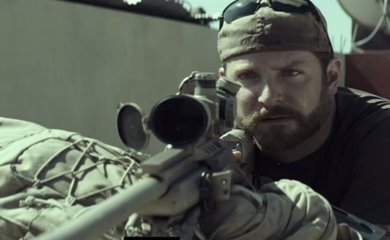What makes a sniper American exactly? Being on the right side of a fight? Stencilling “The Punisher” logo on your equipment like a real life Frank Castle? Wearing a baseball cap backwards whilst you slaughter a mother and her son from long range before they can explode a rocket propelled grenade in front of your buddies? Wasn’t that shot lifted directly from “Full Metal Jacket?” And didn’t that make us hate that 12 year old girl’s guts? The sniper in war movies was always the bad guy, a foreign wraith on the battlefield obliterating our favourite grunts before shifting position like the low down scumbag coward they wished they had the decency to be. How does America square this particularly vicious circle?
Clint Eastwood’s “American Sniper” does its best to turn this cinematic pariah into a modern Hollywood hero. Eastwood himself has got form with a telescopic sight in “The Good, the Bad and the Ugly” and “Dirty Harry” but his persona was always that of the ruthless anti-hero, carefully constructed alongside Sergio Leone and Don Siegel. If the young Eastwood had pulled the trigger on women and children we’d be outraged. Bradley Cooper on the other hand is an all-American beefcake who may be taking on edgier roles but is still soft around his handsome edges. With Cooper as real life Navy SEAL Chris Kyle we’ll forgive him any atrocity.
Kyle joined the Navy SEALs after the terrorist attacks on the U.S. embassies in Dar es Salaam and Nairobi and deployed to Iraq after the September 11th attacks. Eastwood’s trademark crisp, no frills direction races through Kyle’s backstory as a kid with a gift for hunting, macho rodeo rider and then documents his ruthless boot camp training, in between meeting his wife Taya. Here Eastwood veers dangerously close to lampooning his cartoonish portrayal of the invasion of Grenada, “Heartbreak Ridge.” When SEALs use each other as human dartboards in a bar we almost expect Eastwood as Gunny to enter the scene and make them guess what T-shirt he’s wearing today.
With Kyle fully committed to the “War on Terror” in Iraq, we quickly realise that America is more than capable of terrifying the opposition on a vast scale through random killings that strike out of nowhere. The insurgents have IEDs and suicide bombers but Uncle Sam has snipers. Kyle channels the spirit of Whitman and Oswald on the rooftops as he ramps up his kills until a bounty of $180,000 is placed on his head. In another life Clint Eastwood might have collected. Instead he beguiles us with sharp, tense combat sequences as Kyle duels with an insurgent sniper much like the fabled (and now heavily doubted) contest in Stalingrad between Zaitsev and the head of the German sniper school in Zossen.
America hates second place so “American Sniper’s” tagline tells us that Kyle was “the most lethal sniper in U.S. history,” and many often confuse (deliberately or otherwise) U.S. history with history full stop. That dubious honour falls to Zaitsev himself who at least was defending his home soil from invaders who committed war crimes on an industrial scale. Cooper’s Kyle is a fascinating and alluring subject for a Hollywood film as his struggles with PTSD at least point to a conscience that goes someway to excusing his lethal profession. The real Kyle was vastly more complex telling unsubstantiated stories of his deployment to New Orleans to shoot armed looters or his alleged slaying of two would be carjackers. “American Sniper” is a well-directed recruitment film that features an American hero who once told a Colonel, “I don’t shoot people with Korans. I’d like to but I don’t.”

